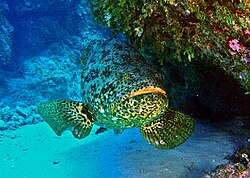Atlantic goliath grouper
| Atlantic goliath grouper | |
|---|---|

| |
| Scientific classification | |
| Kingdom: | |
| Phylum: | |
| Class: | |
| Order: | |
| Family: | |
| Genus: | |
| Species: | E. itajara
|
| Binomial name | |
| Epinephelus itajara (Lichtenstein, 1822)
| |
The Atlantic goliath grouper or itajara (Epinephelus itajara) is a large saltwater fish of the grouper family. It was formerly known as the jewfish; however, in 2001 the Committee on Names of Fishes, a seven-member joint committee of the American Society of Ichthyologists and Herpetologists and the American Fisheries Society made the decision to change the name to "Goliath Grouper".[2] Genus Epinephelus also includes the Pacific goliath grouper.
The goliath grouper is found primarily in shallow tropical waters among coral and artificial reefs at depths of up to 165 feet (50 m). Their range includes the Florida Keys, the Bahamas, most of the Caribbean, and practically all of the Brazilian coast, where they are known as mero. On some occasions it is caught in New England off Maine and Massachusetts but it is not that common. In the eastern Atlantic Ocean, it occurs from Congo to Senegal.
Young grouper may live in brackish estuaries, canals and mangrove swamps, unusual behavior among grouper.

They may reach extremely large sizes, growing to lengths of 8.2 feet (2.5 m) and can weigh as much as 800 pounds (363 kg). In Florida, the largest hook and line captured specimen weighed 680 pounds (309 kg). They are usually around 400 lb when mature. Considered of fine food quality, the goliath grouper were a highly sought after quarry for fishermen of all types. The goliath grouper's inquisitive and generally fearless nature make it a relatively easy prey for spear fishermen. They also tend to spawn in large aggregations returning like clockwork to the same locations making them particularly vulnerable to mass harvesting. Until a harvest ban was placed on the species, the species was in rapid decline. The goliath grouper is totally protected from harvest and is recognized as a critically endangered species by the World Conservation Union (IUCN).[1] The U.S. began protection in 1990 and the Caribbean in 1993. The species' population has been recovering since the ban, however with the fish's slow growth rate it will take some time for populations to return to their previous levels.
Goliath groupers eat crustaceans, other fish, octopuses and young sea turtles. Groupers are preyed upon by large fish such as barracuda, moray eels and large sharks.
Goliath groupers are believed to be protogynous hermaphrodites, with individuals first maturing as females and only some large adults becoming males. Most grouper follow this pattern, but it has not yet been verified for the goliath.[3] In fact, Bullock et al. found that males could be sexually mature at smaller sizes (~1150 mm) and younger ages (4–6 years) than females (~1225 mm and ~6–8 years).[4]
References
- ^ a b Template:IUCN2007 Database entry includes a range map and a lengthy justification of why this species is critically endangered
- ^ Tompkins, Shannon (2001-05-20), "Strange things happen in threes", Houston Chronicle, pp. Sports 2, Page: 20
{{citation}}: CS1 maint: date and year (link) - ^ http://www.flmnh.ufl.edu/fish/gallery/descript/goliathgrouper/goliathgrouper.html Florida Museum of Natural History
- ^ Bullock et al. (1992) Age, Growth and Reproduction in the Eastern Gulf of Mexico U.S. Fishery Bulletin 90(2):243-249 retrieved April 8, 2008 from http://myfwc.com/Marine/grouper/goliath_grouper/reports.htm
External links
- Froese, Rainer; Pauly, Daniel (eds.). "Epinephelus itajara". FishBase. October 2004 version.
- Florida Museum of Natural History description including alternate names
- "Atlantic goliath grouper" at the Encyclopedia of Life

